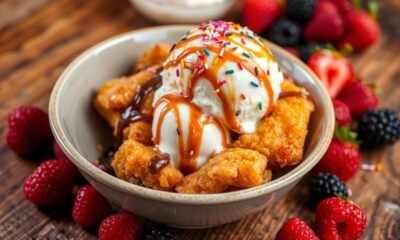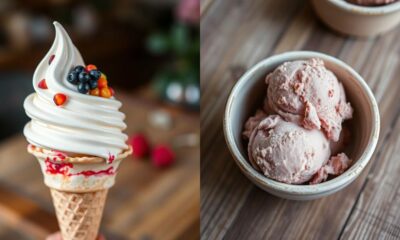Vetted
Turkish Ice Cream: A Unique Texture and Taste You Need to Try
Just one taste of Turkish ice cream, Dondurma, will leave you craving more—discover its unique texture and flavors that redefine frozen treats.

Turkish ice cream, known as Dondurma, offers a one-of-a-kind experience with its chewy texture and delightful flavors. Made with unique ingredients like salep flour and mastic gum, it's resistant to melting, making it perfect for social gatherings. You'll find enticing flavors like pistachio, chocolate, and rosewater that set it apart from traditional ice cream. Vendors serve it in playful ways, slicing it instead of scooping, enhancing the joy of indulging in this treat. If you're curious about where to find authentic Dondurma or its health benefits, there's much more to explore!
Key Takeaways
- Turkish Ice Cream, known as Dondurma, features a unique chewy texture and resists melting, enhancing the overall experience.
- Key ingredients like sahlep and mastic contribute to its distinct flavor, elasticity, and floral aroma.
- Dondurma is traditionally prepared using labor-intensive methods, ensuring freshness and quality with weekly batches.
- It offers a variety of flavors including pistachio, chocolate, and seasonal options, showcasing Turkey's rich culinary heritage.
- Enjoying Dondurma is a cultural experience, often served with entertaining tricks by vendors, fostering social connections.
Overview of Turkish Ice Cream
Indulging in Turkish ice cream, or Dondurma, offers a delightful experience that sets it apart from traditional ice creams. This unique treat is known for its chewy texture, thanks to the use of salep flour and natural mastic gum. These key ingredients not only contribute to its distinct mouthfeel but also enhance its rich flavor profile.
Notably, many vegans seek alternatives to traditional desserts, making it essential to verify the ingredients in various ice creams, including vegan dietary considerations for those avoiding animal products.
When you try Dondurma, you'll notice it's resistant to melting, which makes for a fun serving experience. Vendors often perform playful tricks, teasing you as they scoop and stretch the ice cream before handing it over.
The most famous Dondurma comes from Kahramanmaraş, Turkey, where artisans craft it using a specific method that amplifies its elasticity and taste.
You'll find a variety of flavors, including pistachio, chocolate, and strawberry, but don't miss out on the unique mastic gum flavor. Its floral aroma adds an unexpected twist that many people love.
Beyond being just a delightful dessert, Turkish ice cream holds cultural significance, often enjoyed during social gatherings and celebrations, showcasing a unique aspect of Turkish culinary heritage that you won't want to miss.
Unique Ingredients and Preparation
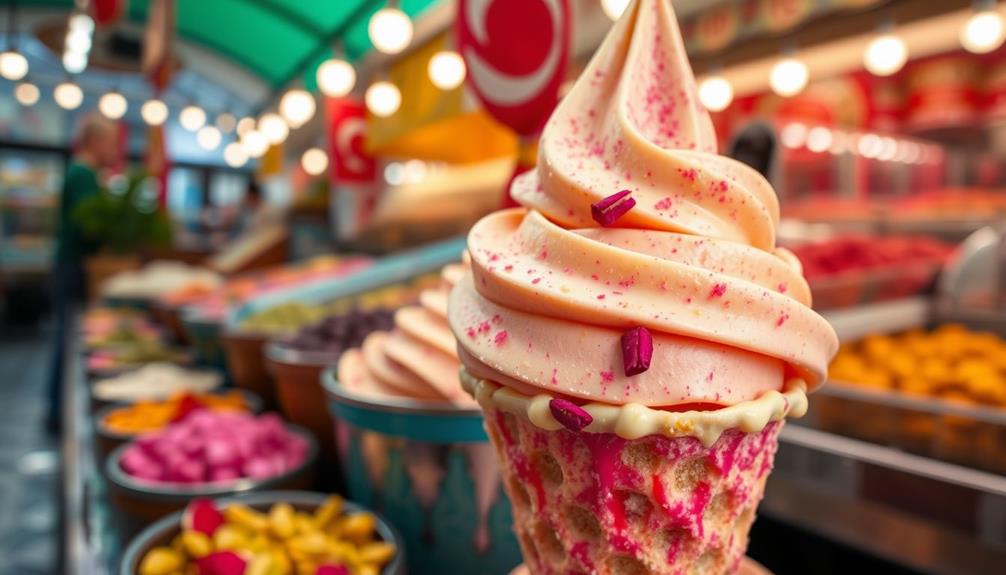
When you think about Turkish ice cream, or dondurma, you'll notice its unique ingredients, like mastic and sahlep, that set it apart.
These components not only give it a chewy texture but also influence the traditional preparation methods that make it so special.
The use of natural ingredients in Turkish ice cream mirrors the benefits of essential oils, as both can enhance overall enjoyment and well-being through their unique properties.
For instance, essential oils for relaxation can create a calming atmosphere, much like the comforting experience of enjoying a scoop of dondurma.
Let's explore how these ingredients come together and the flavor variations you can find.
Key Ingredients Overview
Turkish ice cream, known as dondurma, stands out due to its unique ingredients that set it apart from traditional varieties. The key ingredients together create a texture and flavor profile you won't find elsewhere.
Here's a quick overview of what makes dondurma special:
1. Sahlep: This flour, derived from the tubers of wild orchids, gives dondurma a rubber-band-like stretch. It helps the ice cream hold its shape and resist melting, guaranteeing a delightful experience.
Similar to how aromatherapy uses essential oils for their therapeutic properties, sahlep enhances the sensory experience of dondurma.
2. Mastic: This natural gum adds a floral aroma and a distinct flavor to the ice cream. Its chewy texture elevates the overall taste profile, making each scoop an adventure.
3. Fresh Ingredients: Dondurma is typically made weekly using milk, sugar, and the key ingredients together. This maintains peak freshness and allows for popular flavors like pistachio, chocolate, and rosewater to shine.
Together, these ingredients create a creamy consistency that's not just a treat but a cultural experience.
Once you try dondurma, you'll understand why it's a beloved delicacy in Turkey!
Traditional Preparation Methods
There's something enchanting about the traditional preparation of dondurma that sets it apart from other ice creams. The unique ingredients, such as sahlep and mastic gum, play a vital role in creating that chewy texture you love. Sahlep provides a rubber-band-like stretch, while mastic enhances elasticity and flavor, resulting in a mouthfeel you won't forget.
The process starts with mixing milk, sugar, and flavoring agents, followed by churning with a large wooden paddle in a barrel. This labor-intensive method can take up to an hour, ensuring that each batch is perfectly crafted. Fresh dondurma is made weekly, highlighting the importance of high-quality, natural ingredients.
Here's a quick look at the preparation process:
| Step | Description | Time Required |
|---|---|---|
| Mixing | Combine milk, sugar, and flavoring agents | 15 minutes |
| Churning | Use a wooden paddle in a barrel | Up to 1 hour |
| Serving | Showcasing tricks by vendors | Instant fun |
When you experience dondurma, you're not just enjoying ice cream; you're participating in a delightful Turkish tradition.
Flavor Variations Available
Dondurma offers a delightful array of flavor variations that capture the essence of Turkish cuisine. Each scoop is a blend of unique ingredients, with mastic gum and sahlep giving it that characteristic chewy texture.
You'll find popular ice cream flavors like:
- Pistachio – A classic choice, its nutty richness is irresistible. Unique options for a small breed
- Chocolate – Smooth and creamy, it satisfies any chocolate lover's cravings.
- Rosewater – Delicate and fragrant, this flavor transports you to a blooming garden.
The preparation of dondurma is just as enchanting as its flavors. By cooking the ingredients slowly, vendors achieve a creamy consistency, and the high egg yolk content enhances its richness.
Seasonal variations pop up regularly, introducing exciting limited-time flavors that keep you coming back for more.
When you visit a dondurma stand, don't just indulge in the taste; enjoy the cultural experience as vendors perform playful tricks while serving. This adds a layer of enjoyment that makes every bite even sweeter.
Traditional Serving Techniques

Vendors expertly showcase their skills when serving traditional Turkish ice cream, creating an enchanting experience for customers. When you approach a Dondurma stand, you'll likely notice the vendor dressed in traditional attire, immediately immersing you in the cultural ambiance.
The ice cream is served in slices rather than the usual scoops, which not only looks visually appealing but also emphasizes its unique texture. This type of ice cream has a chewy consistency that's quite different from typical varieties, reminiscent of how certain animals, like cats, exhibit unique preferences in their environments, such as environmental preferences of cats.
Thanks to the elasticity and chewiness of Dondurma—thanks to ingredients like sahlep and mastic—vendors can perform impressive tricks and flips while serving. You might find yourself playfully trying to grab the ice cream as the vendor skillfully teases you, adding an element of fun to the traditional serving techniques.
This playful interaction enhances your experience, making it more than just a treat; it becomes a memorable event. As you savor each slice, you'll appreciate how Dondurma maintains its shape even during these entertaining displays.
The combination of traditional serving techniques and engaging vendor antics transforms your ice cream indulgence into a delightful cultural experience that you won't forget.
Popular Flavors to Try
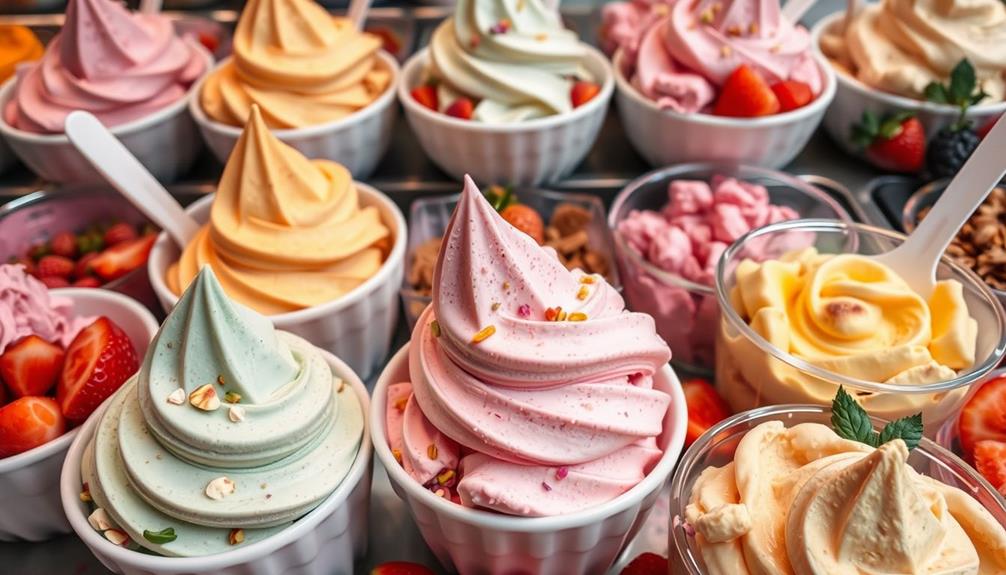
When you indulge in Turkish ice cream, you'll discover a delightful array of flavors that reflect the country's rich culinary traditions. Each scoop offers a unique experience, and you won't want to miss these popular choices, which can be paralleled with the innovative products found in the coffee market, such as mushroom coffee pods that enhance both flavor and health benefits.
- Mastic Gum: This flavor features a unique floral aroma and chewy texture, sourced from Chios, Greece. It's a must-try for anyone looking to experience something truly authentic.
- Pistachio: With its nutty flavor, pistachio complements the creaminess of the ice cream perfectly. It's a staple that many locals and visitors adore.
- Turkish Coffee: For a rich twist, try the Turkish coffee flavor, which combines the bold taste of coffee with a hint of sweetness. It's an experience that will remind you of the famous Turkish delight.
You'll also find classic options like chocolate and vanilla, which maintain the distinctive chewy consistency of dondurma.
And don't overlook fruity choices like fresh strawberry or inventive combinations like rosewater. Each flavor tells a story, inviting you to savor the essence of Turkish culture with every bite.
Cultural Significance of Dondurma
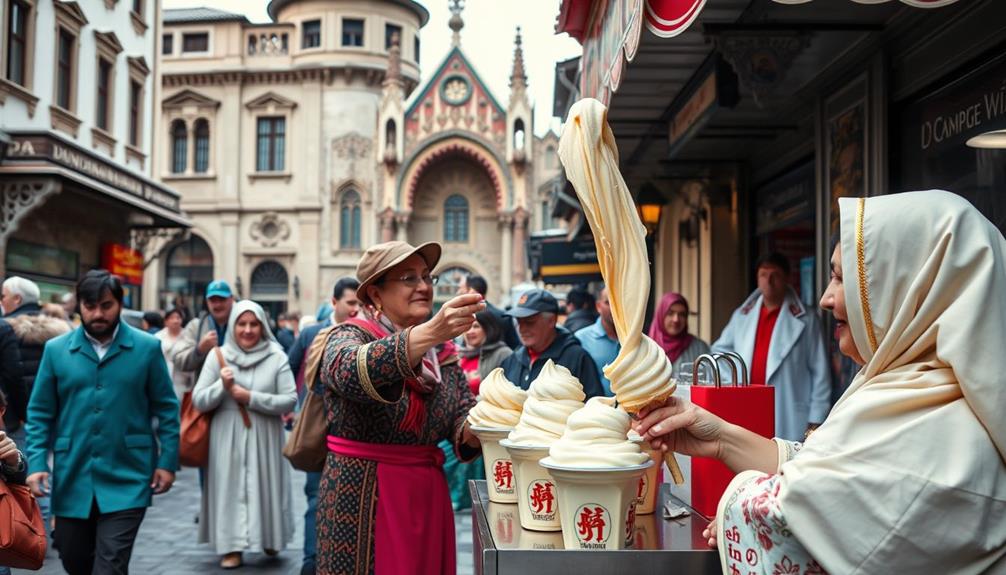
Celebrating community and hospitality, dondurma holds a special place in Turkish culture. This traditional ice cream isn't just a treat; it's a symbol of togetherness, often enjoyed during social gatherings and celebrations.
When you visit a dondurma shop, you'll see families and friends bonding over this delightful dessert, making it a central part of their interactions. The lively atmosphere created by the unique serving techniques of dondurma vendors adds an entertaining twist to the experience, reminiscent of the fun found in party games that enhance laughter and camaraderie.
You'll often find them performing tricks with the ice cream, creating a lively atmosphere that enhances your enjoyment. These shops serve as popular meeting places, where laughter and shared stories fill the air, making dondurma an essential element of social life in Turkey.
The cultural significance of dondurma goes beyond just taste; it's embedded in the very fabric of Turkish culinary heritage. In fact, some households even measure their fridge sizes by how much dondurma they can store!
With its rich history and unique preparation methods, dondurma stands as a beloved delicacy that continues to connect people, both locally and internationally. It's not just ice cream; it's a celebration of Turkish culture.
Health Benefits and Nutritional Value
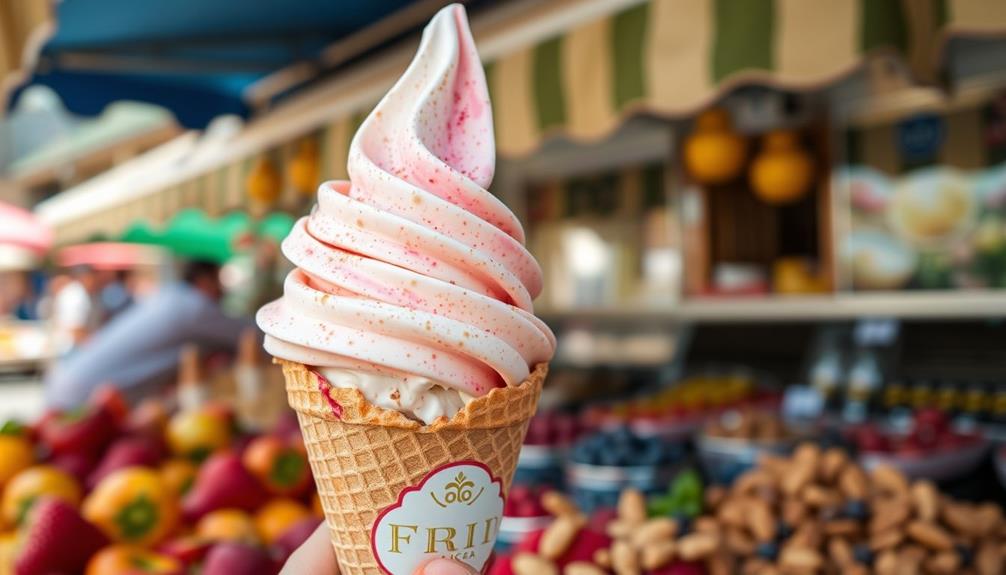
Turkish ice cream, or dondurma, offers several health benefits that make it a unique indulgence. Unlike conventional ice cream, dondurma boasts a range of nutritional advantages that can enhance your overall well-being. Here are three key benefits you should know about:
1. Digestive Support: Dondurma is often made with sahlep, which is rich in dietary fiber. This can aid digestion, making it easier for your body to process food.
Additionally, understanding your health and nutritional needs is essential for overall well-being, similar to prioritizing annual mammograms for early detection of breast cancer.
2. Anti-Inflammatory Properties: The inclusion of mastic gum may provide anti-inflammatory benefits, rooted in traditional medicine for its potential health properties.
3. Higher Protein Content: Dondurma contains more protein thanks to the use of milk and egg yolks. This can contribute to muscle maintenance and support your overall health.
Additionally, the natural ingredients like pistachios and rosewater are packed with antioxidants that help combat oxidative stress.
Plus, with less air whipped into it, this ice cream is denser, which might help you feel full longer.
Where to Find Authentic Dondurma

If you're craving authentic dondurma, check out local Turkish ice cream shops that celebrate traditional recipes.
These shops often embody the cottagecore aesthetic, emphasizing simplicity and a connection to nature, which enhances the overall dining experience.
You'll find unique flavors like mastic and sahlep that are hard to resist, making it a delightful option for those seeking eco-tours in culinary form.
Plus, many Turkish restaurants and cafes serve this delightful treat alongside classic desserts, giving you a true taste of Turkish culture.
Local Turkish Ice Cream Shops
Stepping into a local ice cream shop in Turkey is like entering a world of delightful flavors and enchanting traditions.
You'll quickly notice the unique serving techniques, where vendors entertain you with their playful tricks while dishing out the delicious dondurma. The experience is further enriched by the charming decor elements reminiscent of a modern farmhouse aesthetic, creating a cozy yet vibrant atmosphere.
To help you navigate the vibrant ice cream scene, here are three must-visit locales:
- Istanbul – The heart of Turkish ice cream culture, where you'll find a variety of flavors like pistachio, chocolate, and rosewater.
- Antalya – Known for its stunning scenery, this coastal city boasts charming ice cream shops that serve authentic dondurma made from high-quality sahlep.
- Izmir – This bustling port city offers a mix of traditional and modern ice cream shops, allowing you to experience the best of both worlds.
Each of these local Turkish ice cream shops sources their sahlep from specific regions, ensuring that the texture and flavor are truly authentic.
Pair your dondurma with traditional desserts like baklava for a complete culinary experience. Embrace the lively atmosphere and enjoy the social essence of these beloved ice cream spots!
Popular Dondurma Flavors
When it comes to dondurma, a world of flavors awaits you, from the beloved classics to intriguing specialty options. You'll find traditional favorites like pistachio, chocolate, and strawberry, but don't miss out on unique varieties such as mastic gum, which adds a chewy texture and floral aroma to your experience.
To help you navigate the delicious options, here's a quick overview of popular dondurma flavors:
| Classic Flavors | Unique Varieties | Seasonal Options |
|---|---|---|
| Pistachio | Mastic Gum | Mango Sorbet |
| Chocolate | Rose Petal | Matcha |
| Strawberry | Saffron | Lavender |
Authentic dondurma is best found in Turkish ice cream shops, especially in regions like Kahramanmaraş, where quality reigns supreme. Many vendors delight you with playful serving techniques, flipping and juggling the ice cream as they scoop. You can also find dondurma in Mediterranean neighborhoods and specialty dessert shops across the U.S., often made with traditional ingredients like sahlep and mastic for that true taste. So go ahead, indulge in the rich variety of dondurma flavors waiting for you to explore!
Frequently Asked Questions
What Is Unique About Turkish Ice Cream?
Turkish ice cream's uniqueness lies in its chewy texture from mastic and sahlep, which makes it elastic and resistant to melting. You'll love the playful serving style and rich, creamy flavors that tantalize your taste buds. Turkish ice cream is commonly served with a long-handled spoon, and the “ice cream man” often performs tricks, such as flipping and tossing the ice cream, to entertain customers. In addition to enjoying it in its traditional form, you can also discover the best ice cream recipes featuring Turkish flavors like pistachio, rosewater, and honey. These delicious desserts are a unique way to add a touch of exotic flair to your next sweet treat.
What Is the Famous Turkish Ice Cream?
The famous Turkish ice cream is dondurma. Its unique chewy texture comes from ingredients like mastic gum and sahlep. You'll love how it's served by vendors, often accompanied by delightful traditional desserts like baklava.
What Is Turkish Ice Cream Prank?
The Turkish ice cream prank involves vendors playfully pulling the ice cream away as you reach for it. This fun trick showcases its unique elasticity and adds excitement to your ice cream-buying experience.
What Does Turkish Delight Ice Cream Taste Like?
You won't believe the explosion of flavors in Turkish Delight Ice Cream! It's a dreamy blend of floral rosewater and chewy mastic, creating an unforgettable taste experience that dances on your palate like a joyful celebration.
Conclusion
In the world of desserts, Turkish ice cream stands out like a gem in a treasure chest. Its unique texture and delightful flavors offer an experience that's simply unforgettable. As you savor each creamy bite, you'll not only indulge your taste buds but also immerse yourself in a rich cultural tradition. So, whether you're enjoying it in a bustling market or at a cozy café, don't miss the chance to try this extraordinary treat. Additionally, the presentation of Turkish ice cream is a sight to behold, with vendors using their skills to perform captivating tricks as they serve it to eager customers. The sweet ice cream drawing ideas are a form of entertainment that adds to the overall experience, making it a treat for all the senses. From its origins in the Ottoman Empire to its popularity around the world today, Turkish ice cream truly has a story as rich and fascinating as its flavor.
Lorenzo is our resident ice cream connoisseur and an expert in all things frozen. With years of experience in food writing and a deep knowledge of culinary trends, Lorenzo crafts in-depth, well-researched articles that offer a unique perspective on the world of ice cream. Whether delving into the history of a classic flavor or reviewing the latest products on the market, Lorenzo’s work is thorough, thoughtful, and constantly engaging.
Vetted
Does Dairy Queen Have Dairy Free Ice Cream?
Not only does Dairy Queen offer a dairy-free ice cream option, but there are also other surprising treats waiting to be discovered.

Yes, Dairy Queen does have a dairy-free ice cream option. Their Non-Dairy Dilly Bar features a creamy coconut vanilla center that's dipped in chocolate. This treat is vegan-certified and gluten-free, making it a great choice for those with dietary restrictions. You can find it at participating locations, either individually or in boxes of six. Additionally, Dairy Queen offers other dairy-free items like Starkiss popsicles and French fries. If you want to know more about their full range of dairy-free options, you won't want to miss the details ahead.
Key Takeaways
- Dairy Queen offers a Non-Dairy Dilly Bar, featuring a coconut vanilla center dipped in chocolate, which is vegan-certified and gluten-free.
- The Non-Dairy Dilly Bar is the primary dairy-free ice cream option available at Dairy Queen locations.
- Dairy Queen's menu includes other dairy-free items like Starkiss Popsicles and French Fries (without queso).
- Customers should verify potential cross-contamination when ordering dairy-free options at Dairy Queen.
- Using the DQ app, customers can check local availability of the Non-Dairy Dilly Bar.
Dairy Queen's Non-Dairy Options
Dairy Queen has made strides in offering non-dairy options, making it easier for those with dietary restrictions to enjoy a treat. One standout item on their dairy-free menu is the Non-Dairy Dilly Bar, which features a creamy coconut vanilla center dipped in chocolate. This delicious bar not only satisfies your sweet tooth but is also gluten-free and vegan-certified, allowing you to indulge without worry.
Many popular desserts, like ice cream, often contain non-vegan ingredients such as milk or eggs, so it's invigorating to see vegan-friendly alternatives becoming more available.
Launched nationwide in April 2020, the Non-Dairy Dilly Bar represents a significant step for Dairy Queen in catering to customers seeking vegan options. While you won't find traditional dairy-free ice cream at Dairy Queen, this innovative treat provides a satisfying alternative. You can grab a single Non-Dairy Dilly Bar or opt for a box of six at participating locations.
Dairy Queen's commitment to expanding its dairy-free menu means you're no longer left out when everyone else is enjoying a sweet treat.
Understanding Dairy-Free Products

When exploring dairy-free products, it's vital to understand what qualifies as dairy-free and how to identify suitable options. Many people seek out vegan and non-dairy ice cream alternatives, but not all products meet these criteria.
At Dairy Queen, traditional ice cream is dairy-based, but they do offer a few options that cater to those with dairy restrictions. Embracing these dietary changes can lead to a deeper understanding of personal preferences and health needs, serving as a catalyst for heartbreak and healing in one's dietary journey.
Here are some key points to take into account when choosing dairy-free products:
- Ingredients: Check the ingredient list for dairy derivatives, such as milk or cream.
- Cross-Contamination: Inquire about the risk of cross-contamination, especially in restaurants like Dairy Queen.
- Certifications: Look for vegan or dairy-free certifications on packaging.
- Specific Products: Be aware that Dairy Queen's Non-Dairy Dilly Bar is a chocolate-dipped treat with a coconut vanilla cream center, making it a great option for those avoiding dairy.
While Dairy Queen doesn't offer traditional non-dairy ice cream, the Non-Dairy Dilly Bar and other items like Starkiss Popsicles provide tasty alternatives.
Always double-check allergen information to guarantee you're making safe choices.
Flavor Profiles of Dairy-Free Treats

When you try Dairy Queen's Non-Dairy Dilly Bar, you'll immediately notice the creamy coconut flavor that makes it stand out.
This delectable treat is a wonderful addition to the growing market of creamy plant-based ice cream options, catering to those seeking dairy-free alternatives. Its rich, smooth texture rivals traditional dairy ice creams, making it a favorite among vegans, individuals with lactose sensitivities, and even those simply looking to indulge in a healthier dessert option. As the demand for dairy-free alternatives grows, well-known brands are expanding their offerings, such as the dairyfree alternatives at Cold Stone, ensuring that everyone can enjoy a frozen treat without compromise.
The indulgent chocolate coating adds a rich layer of sweetness, enhancing your dessert experience.
Together, these elements create a delicious treat that's perfect for any occasion.
Creamy Coconut Flavor
Indulging in a treat that captures the essence of creamy coconut can be a delightful experience, especially with Dairy Queen's Non-Dairy Dilly Bar. This dairy-free ice cream offers a luxurious coconut vanilla cream center that's both rich and satisfying, making it an excellent choice for those avoiding dairy.
Imagine the joy of savoring a frozen dessert that combines:
- Smooth coconut cream-based protein for a sweet, creamy taste
- A blissful, dairy-free option that's gluten-free and certified vegan
- A delightful treat that feels like a frozen paradise
- A perfect balance of flavors that satisfies your cravings
The Non-Dairy Dilly Bar is crafted to deliver an indulgent experience without the guilt, ensuring everyone can enjoy a taste of paradise.
Whether you're vegan, lactose intolerant, or simply looking to try something new, this coconut treat from Dairy Queen checks all the boxes.
Indulgent Chocolate Coating
The experience of biting into Dairy Queen's Non-Dairy Dilly Bar is elevated by its indulgent chocolate coating, which adds a layer of richness to the creamy coconut vanilla center. This delightful treat isn't just about taste; it's crafted to cater to various dietary needs while delivering a satisfying dessert experience.
| Feature | Details | Benefits |
|---|---|---|
| Base Flavor | Creamy Coconut Vanilla | Rich, creamy texture |
| Coating | Indulgent Chocolate Coating | Sweetness with crunch |
| Calories | 240 | Guilt-free indulgence |
| Dietary Options | Gluten-free, Plant-based | Inclusive for many diets |
| Overall Experience | Dairy-free Delight | Mimics traditional ice cream |
With every bite, the chocolate coating enhances the sweetness, creating a perfect balance with the coconut. You'll appreciate the satisfying crunch that complements the smoothness of the Non-Dairy Dilly Bar. It's a blissful option for those seeking a dairy-free treat that doesn't compromise on flavor. Enjoying this indulgent dessert means you can treat yourself without any dairy worries!
Popular Dairy-Free Menu Items
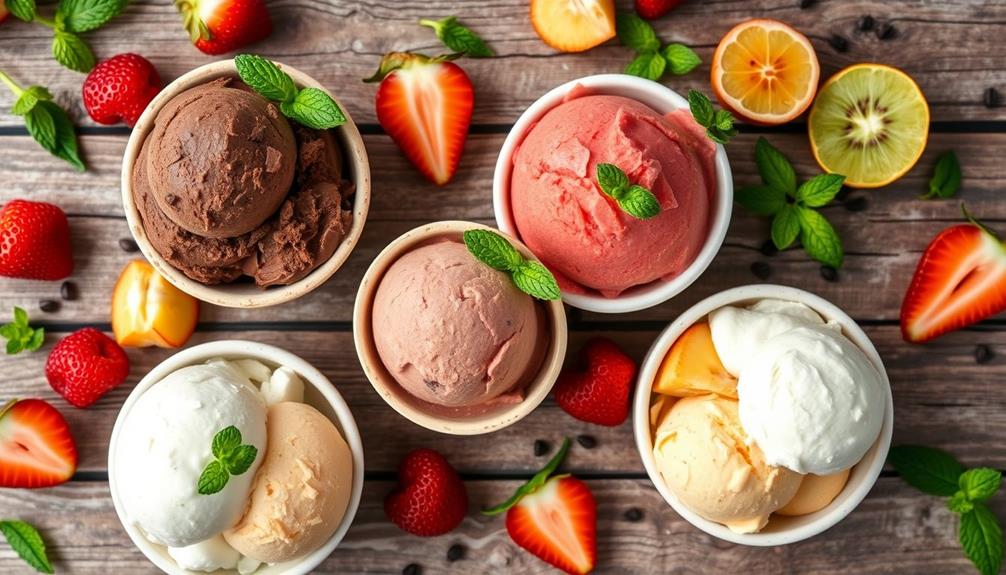
Dairy Queen's menu includes some exciting dairy-free options that satisfy sweet cravings without compromising dietary needs. While traditional dairy-free ice cream isn't available, you can indulge in the delightful Non-Dairy Dilly Bar. This treat features a creamy coconut vanilla center coated in rich chocolate, and it's both vegan and gluten-free.
It's a fantastic way to enjoy a sweet dessert while sticking to your dietary preferences.
Here are some popular dairy-free menu items you can enjoy at Dairy Queen:
- Non-Dairy Dilly Bar – A creamy coconut vanilla center with a chocolate coating.
- Starkiss Popsicles – Invigorating tri-flavored popsicles in cherry, watermelon, and blue-raspberry.
- French Fries – Crispy and satisfying, perfect as a snack or side.
- Pretzel Sticks – Delicious on their own, just skip the queso for a dairy-free option.
Additionally, you'll find side salads that make for great dairy-free snacks.
While Dairy Queen doesn't currently offer dairy-free ice cream cakes or Blizzard options, these selections make it easier for you to enjoy a treat without the worry of dairy.
Availability and Ordering Process

When you're ready to satisfy your sweet tooth with Dairy Queen's dairy-free options, knowing how to find and order them makes all the difference. While Dairy Queen doesn't offer traditional dairy-free ice cream, you can indulge in the Non-Dairy Dilly Bar, made with coconut cream. This sweet treat is available at participating DQ locations, so be sure to check if your nearest spot carries it.
To make ordering easier, consider using the DQ app. It allows you to check local availability and place orders conveniently. The Non-Dairy Dilly Bar comes individually or in boxes of six, perfect for sharing or treating yourself!
Here's a quick reference to help you navigate your options:
| Item | Details |
|---|---|
| Non-Dairy Dilly Bar | Dairy-free, gluten-free, plant-based |
| Availability | At participating DQ locations |
| Ordering Options | Individual or box of six |
| Cross-Contamination | Check with staff at your location |
Remember to verify with the staff about cross-contamination, as some items are prepared in shared facilities. Enjoy your dairy-free delight!
Complementary Snacks and Sides

Looking to round out your dairy-free treat? Dairy Queen has some great complementary snacks and sides that can elevate your experience. You can enjoy a satisfying meal alongside your Non-Dairy Dilly Bar, which is made with coconut cream and coated in chocolate.
Here are some tasty options that'll keep your dairy-free diet on track:
- French fries (just skip the queso!)
- Hash browns
- Pretzel sticks (hold the butter)
- Side salad (check for cross-contamination)
For an extra flavor kick, pair your fries or chicken strips with dairy-free dipping sauces like BBQ or ketchup.
Remember, menu items can vary by location, so it's a good idea to confirm the availability of these dairy-free options with the staff when you order.
With these snacks, you can create a delicious, dairy-free meal that perfectly complements your sweet treat!
Community Feedback and Engagement

Engagement with the community is essential for Dairy Queen as it endeavors to enhance its menu offerings, including dairy-free options. By actively encouraging community feedback, Dairy Queen invites you to share your thoughts through surveys sent to DQ App users. This open line of communication allows you to express your requests for dairy-free options directly to local managers, fostering a dialogue about possible menu improvements.
Dairy Queen also connects with its audience on social media platforms, making it easy for you to suggest ideas and insights regarding menu options, including vegan and dairy-free items. This level of engagement is vital because it helps the company understand customer needs more effectively.
Moreover, positive experiences shared by users who've found dairy-free choices highlight the growing importance of customer feedback in shaping menu offerings.
Dairy Queen's commitment to community involvement, reflected in its support of initiatives like the Children's Miracle Network, further demonstrates its responsiveness to what you and other customers want. This ongoing interaction strengthens the bond between Dairy Queen and its community, ensuring that everyone's dietary preferences are considered as the menu evolves.
Advocacy for Dairy-Free Offerings

As consumers increasingly seek plant-based alternatives, Dairy Queen has stepped up its advocacy for dairy-free offerings. The introduction of the Non-Dairy Dilly Bar in April 2020 marked a significant milestone in their menu evolution, catering to the rising demand for dairy-free desserts. This delicious treat features a coconut cream center and is both wheat and gluten-free, making it an appealing choice for many.
Dairy Queen's advocacy is further bolstered by petitions from organizations like PETA, reflecting your growing interest in dairy-free options.
Here's what you can expect from Dairy Queen's push for more plant-based alternatives:
- The Non-Dairy Dilly Bar adds variety to your dessert choices.
- Community feedback is actively encouraged, allowing you to voice your preferences.
- There's a hope for future dairy-free innovations, like dairy-free Blizzards.
- The demand for vegan options is being taken seriously by the brand.
With these efforts, Dairy Queen is clearly committed to expanding its dairy-free offerings, ensuring you have more delicious options to enjoy.
Your feedback can help shape the future of their menu, so don't hesitate to speak up!
Historical Context of Dairy-Free Options

In April 2020, Dairy Queen took a significant step by launching the Non-Dairy Dilly Bar, responding to an increasing demand for dairy-free options.
This move came alongside a broader industry trend where fast-food chains began expanding their vegan menu offerings.
Understanding this historical context helps you see how consumer preferences have shaped Dairy Queen's menu and the fast-food landscape.
Launch of Non-Dairy Dilly Bar
Expanding its menu to include the Non-Dairy Dilly Bar in April 2020 marked a significant milestone for Dairy Queen, showcasing the brand's commitment to catering to diverse dietary needs.
This delicious treat features a coconut vanilla cream center, coated in chocolate, making it a tempting dairy-free option for anyone avoiding traditional ice cream.
Here's what you can expect with the Non-Dairy Dilly Bar:
- Certified Vegan: Perfect for those following a plant-based diet.
- Gluten-Free: Suitable for individuals with gluten sensitivities.
- Rich Flavor: The combination of coconut and chocolate offers a delightful taste experience.
- Timely Launch: Introduced during shelter-in-place orders, reflecting the growing demand for non-dairy options.
The introduction of the Non-Dairy Dilly Bar not only emphasizes Dairy Queen's response to changing consumer preferences but also aligns with advocacy efforts for more dairy-free options.
As you savor this treat, you can appreciate the way Dairy Queen is evolving its menu, paving the way for potential future additions, like dairy-free Blizzards.
Growing Vegan Menu Options
The growing demand for vegan menu options has reshaped the fast-food landscape, with Dairy Queen leading the charge in embracing dairy-free alternatives. In April 2020, Dairy Queen launched its Non-Dairy Dilly Bar, a coconut cream-based treat coated in chocolate, marking a significant step toward expanding dairy-free desserts. This move reflects a broader awareness of plant-based diets among consumers, who are increasingly seeking dairy-free options.
Here's a glimpse of Dairy Queen's evolving offerings:
| Dairy Queen Treats | Features |
|---|---|
| Non-Dairy Dilly Bar | Coconut cream center, chocolate coating |
| Future Prospects | Hope for dairy-free Blizzards |
| Consumer Demand | Rising interest in vegan options |
| Advocacy Impact | Support from organizations like PETA |
The introduction of the Non-Dairy Dilly Bar showcases Dairy Queen's commitment to meeting the needs of a diverse customer base. As the vegan market continues to grow, it's exciting to think about what other dairy-free desserts might be on the horizon. With ongoing advocacy and consumer interest, Dairy Queen is poised to expand its vegan menu options even further.
Industry Trends and Awareness
As consumers have shifted their preferences toward plant-based diets, the fast-food industry has stepped up to meet this growing demand for dairy-free options. One notable example is Dairy Queen's introduction of the Non-Dairy Dilly Bar in April 2020, which features a coconut cream base. This move aligns with the broader trend of fast-food chains expanding their vegan menus to accommodate dietary restrictions.
Here are some key trends in this industry:
- Increased awareness of veganism and dietary preferences among consumers.
- Advocacy from organizations like PETA influencing menu changes.
- A gradual rise in plant-based options across various fast-food chains.
- Limited offerings at Dairy Queen, with the Non-Dairy Dilly Bar being one of the few dessert options.
While the Dairy Queen website highlights the Non-Dairy Dilly Bar, it's crucial to recognize that they currently don't offer a dairy-free ice cream option or Blizzards.
This limitation reflects the ongoing evolution within the fast-food sector, as chains adapt to the growing demand for diverse and inclusive menu items. As awareness continues to rise, you can expect more shifts in the availability of dairy-free desserts in the future.
Interesting Facts About Dairy Queen
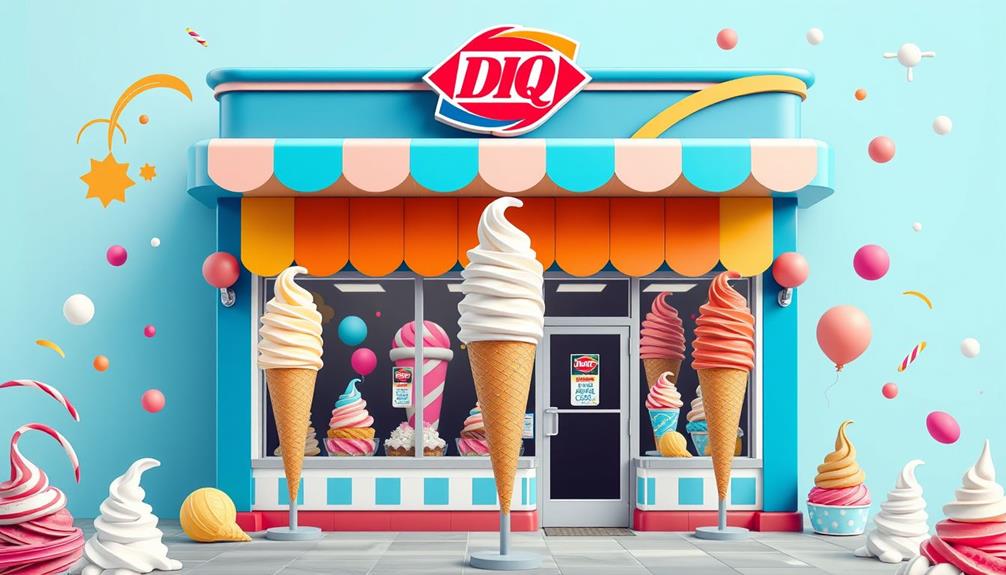
Dairy Queen has a rich history that many fans mightn't know about. Founded in 1940 in Joliet, Illinois, it has since expanded to over 6,000 locations worldwide. You might be surprised to learn that Dairy Queen is owned by Berkshire Hathaway, and it's famous for its soft serve ice cream, classified as reduced-fat ice cream due to its 5% butterfat content.
In 1953, the first Canadian Dairy Queen opened in Estevan, Saskatchewan, marking the brand's expansion beyond the U.S. This international growth highlights how beloved Dairy Queens are across borders.
In response to growing consumer demand for dairy-free options, Dairy Queen introduced the Non-Dairy Dilly Bar in April 2020, allowing more fans to enjoy their treats.
And if you think size matters, consider that the largest Dairy Queen Blizzard ever created weighed an astonishing 8,224.85 lbs in Springfield, MA! This fun fact showcases the brand's creative marketing and engagement with the community.
Frequently Asked Questions
Can Vegans Eat Dairy Queen Ice Cream?
If you're vegan, you can't eat Dairy Queen's ice cream, since it contains dairy. However, you can enjoy the Non-Dairy Dilly Bar, which is made from coconut cream and is both vegan and gluten-free.
Is Soft Serve Dairy Free?
You might think soft serve could be dairy-free, but it's not. Most options contain dairy, so if you're avoiding it, you'll need to explore other treats—like the Non-Dairy Dilly Bar for a sweet escape.
What Kind of Ice Cream Is Dairy Free?
When you're looking for dairy-free ice cream, consider options made from almond, coconut, or soy milk. These alternatives provide creamy textures and flavors, allowing you to enjoy ice cream without dairy ingredients in your diet.
Is Mcdonalds Ice Cream Dairy Free?
McDonald's ice cream isn't dairy-free; it's made with dairy ingredients. If you're looking for dairy-free options, check with your local McDonald's, but keep in mind they don't typically offer such alternatives on their standard menu.
Conclusion
In a world where indulgence meets inclusivity, Dairy Queen's dairy-free options serve as a rejuvenating oasis for those seeking sweet satisfaction without the dairy. Whether you're savoring a non-dairy Blizzard or a soft-serve treat, you're not just enjoying a dessert; you're embracing a lifestyle that celebrates variety. So, next time you find yourself at Dairy Queen, remember that flavor knows no bounds, and deliciousness is just a scoop away, no matter your dietary needs.
Giulia is the creative force behind our content strategy. With a knack for storytelling and a deep understanding of what our readers want, she plans and develops the content that keeps “Icecream Hater” fresh and exciting. Giulia works closely with the editorial team to ensure that every article, recipe, and review aligns with our mission and vision. She aims to inspire our readers to explore, create, and enjoy ice cream in new and innovative ways.
Vetted
What Is Fried Ice Cream?
A delightful fusion of warm and cold, fried ice cream tempts the taste buds—discover its origins and how to make this irresistible dessert!

Fried ice cream is a delicious dessert that combines a crispy outer shell with a cold, creamy interior. You'll find round scoops of ice cream coated in crushed cornflakes and cinnamon, quickly deep-fried for just 10-15 seconds. This brief frying creates a warm and crunchy exterior while keeping the inside perfectly frozen. Often served with toppings like whipped cream, chocolate sauce, or cherries, it's a popular treat at fairs and restaurants. If you're curious about its origins, preparation tips, and variations, there's a lot more to explore!
Key Takeaways
- Fried ice cream is a dessert featuring cold ice cream coated in a crispy exterior made of crushed cornflakes and cinnamon.
- It is briefly deep-fried at 375°F for 10-15 seconds, maintaining a creamy interior.
- Popular at state fairs and restaurants, it offers a unique contrast of hot and cold textures.
- Often garnished with toppings like whipped cream, chocolate sauce, and maraschino cherries for added flavor.
- Fried ice cream has cultural ties to Asian and Mexican cuisines and gained popularity in the U.S. during the 1970s.
What Is Fried Ice Cream?
Fried ice cream is a unique dessert that combines the contrasting sensations of hot and cold in every bite. This delightful treat features round scoops of ice cream, often referred to as ice cream balls, which are coated in a crunchy layer made from crushed cornflakes and cinnamon.
The magic happens when these coated ice cream balls are briefly deep-fried in oil heated to about 375°F (190°C) for just 10-15 seconds. This quick fry creates a golden brown, crispy exterior while keeping the interior cold and creamy.
It's important to note that while fried ice cream is a delicious indulgence, some of its toppings, like honey, are generally avoided by vegans due to ethical concerns about bee exploitation ethical concerns about bee treatment.
Fried ice cream isn't just about the delicious texture; it's also a feast for the eyes. You can enhance your dessert with various toppings such as whipped cream, chocolate sauce, or honey, and even finish it off with a maraschino cherry.
This dessert has a rich history, gaining popularity at the 1893 Chicago World's Fair, and it often finds its place in Asian and Mexican cuisines through different cultural adaptations.
While it's an indulgent treat, be mindful that the frying process typically results in higher calorie and fat content, making it a special occasion dessert you won't want to miss!
Recipe Overview

Fried ice cream offers a delicious contrast between its crunchy exterior and creamy interior, making it a unique dessert experience. The hot, crispy coating paired with the cold ice cream creates a delightful temperature and texture interplay that excites the palate. With each bite, the sensation is both comforting and intriguing, leaving you wanting more. For those curious about its potential health effects, one might even wonder, does ice cream ease heartburn? While the cold nature of ice cream might provide temporary relief by soothing the esophagus, its high-fat content could potentially exacerbate heartburn for some individuals.
This delightful treat can be enhanced by incorporating innovative flavor profiles that surprise your taste buds.
You'll love experimenting with popular toppings like whipped cream, honey, and cherries to elevate the flavors.
This treat not only impresses but also invites sharing, with each recipe yielding eight delightful servings.
Unique Dessert Experience
Imagine a dessert that combines the unexpected crunch of a golden coating with the smooth creaminess of ice cream—this is fried ice cream. This unique treat provides an exhilarating contrast in textures that delights the senses.
To prepare it, you'll start by scooping ice cream into balls and placing them on a baking sheet. Make sure to freeze these scoops until they're firm, ensuring they hold their shape during frying. For added creativity, consider experimenting with flavors or toppings, similar to how you can customize easy homemade flautas with various fillings.
Next, dip each chilled scoop in egg whites, allowing them to coat the ice cream evenly. Then, roll them in crushed cornflakes for that signature crispy exterior. The real magic happens when you fry these coated ice cream balls briefly at 375°F (190°C). This quick cooking time yields a golden, crunchy shell while keeping the ice cream inside perfectly creamy.
Serving fried ice cream immediately after frying is essential to maintain its ideal texture and flavor. With a recipe that yields eight delightful 1/2-cup-sized portions, you'll have just the right amount to share at your next gathering, creating a truly unforgettable dessert experience.
Popular Toppings Options
When it comes to elevating your fried ice cream, there are several popular toppings that can enhance its deliciousness. Whipped cream is a must; it adds a light, airy texture that complements the creamy interior and crunchy exterior of the ice cream.
For a really nice touch, drizzle honey or chocolate sauce over the top, creating a sweet contrast that takes your dessert to a new level.
Maraschino cherries are a classic garnish that not only provide a pop of color but also a fruity element that brightens the dish. You can also sprinkle cinnamon and sugar on top, echoing the flavors of the cornflake coating for a delightful finish.
If you want to get creative, consider customizing with nuts, sprinkles, or crushed cookies, letting your taste preferences shine through.
If you're in New York, you might find fried ice cream served with a twist, reminiscent of Baked Alaska. This dessert takes the fried ice cream concept to another level, combining elements of both favorites.
No matter how you choose to top yours, these options are sure to create a memorable treat!
Ingredients and Preparation

To make fried ice cream, you'll need some key ingredients like ice cream, cornflakes, and egg whites.
Start by preparing the ice cream balls and coating them for that perfect crunch.
Let's explore the steps and techniques to get your dessert just right!
Essential Ingredients Needed
Fried ice cream often delights dessert lovers with its unique combination of hot and cold. To create this indulgent treat, you'll need a few essential ingredients. First, choose your favorite ice cream flavor; classic options like vanilla or chocolate work wonderfully.
Next, you'll require cornflakes to create that crispy coating. Mixing crushed cornflakes with sugar and cinnamon adds flavor and texture to your dessert.
Egg whites are critical as they act as a binding agent, making certain the cornflake coating adheres to the ice cream balls.
To prepare your ice cream, scoop it into 2-inch balls and freeze them for at least 30 minutes. This step helps maintain the shape during frying.
Once the ice cream balls are coated with the cornflake mixture, it's important to freeze them again for an additional three hours or even up to three days. This extra freezing guarantees that the ice cream remains firm while frying.
Preparation Steps Overview
For a successful fried ice cream experience, start by selecting your favorite ice cream flavors. Scoop them into 2-inch balls and freeze these scoops for about 30 minutes. This step helps maintain their shape during frying.
Next, prepare your coating mixture by following these steps:
- Crush Cornflakes: Crush cornflakes into smaller pieces and mix them with sugar and cinnamon in a shallow dish for that perfect crunchy texture.
- Egg Whites: Roll the frozen ice cream balls in egg whites. This will help the coating stick better.
- Coat Again: After rolling in egg whites, coat the balls again in the cornflake mixture for extra crunch.
- Freeze Again: Place the coated ice cream balls on a parchment-lined baking sheet and freeze them for at least 3 hours, or up to 3 days, to solidify the coating.
When you're ready to fry, heat oil to 360°F. Fry the ice cream balls for just 8-10 seconds until they turn a lovely golden brown. Enjoy your crispy, indulgent treat!
Coating Techniques Explained
Achieving that perfect crunchy exterior for your fried ice cream requires a simple yet effective coating technique. Start by rolling your frozen ice cream balls in a mixture of crushed cornflakes and cinnamon, making sure to cover them evenly. This initial layer gives your dessert that essential crunch.
Next, dip the coated ice cream balls in beaten egg whites. This step helps the second layer of cornflakes stick better, enhancing the texture. After the egg dip, roll the ice cream balls in the cornflake mixture again for an extra crunch. This double coating technique is key to achieving a delightful crunch when fried.
Once you've coated your ice cream balls, it's vital to freeze them for at least 3 hours. This helps maintain their shape and prevents them from melting during the frying process.
To streamline your coating routine, use a shallow dish for the cornflake mixture and a separate bowl for the egg whites. This setup minimizes mess and makes the process more efficient.
With these coating techniques, you'll be well on your way to creating a deliciously crispy fried ice cream treat. Enjoy!
Cooking Process

To create perfectly fried ice cream, start by heating oil to 375°F (190°C). This temperature is essential for achieving that crispy exterior while keeping the ice cream inside frozen.
Once the oil is ready, follow these steps to fry your coated ice cream balls:
- Fry in Batches: Carefully add one or two ice cream balls to the hot oil at a time. Fry them for 10-15 seconds, making sure they turn a beautiful golden brown.
- Use the Right Tools: Utilize a spider tool or slotted spoon to manage the frying process. This helps you carefully place the ice cream in the oil and remove it without splashing.
- Drain Excess Oil: After frying, immediately place the fried ice cream on paper towels. This will absorb any residual oil, giving you a cleaner presentation.
- Serve Quickly: Serve the fried ice cream right after frying. The heat can cause it to melt quickly, so enjoy it while it's still crispy and cold.
Following these steps guarantees you'll have a delicious treat that's both crispy and creamy—perfect for impressing your friends!
Nutritional Information

Enjoying fried ice cream comes with a few nutritional considerations. First off, this indulgent dessert tends to be high in calories. When fried, ice cream typically retains about 10% oil, which contributes to its overall calorie content. Depending on the specific ingredients you choose—like the type of ice cream or coating—nutritional values can vary considerably.
If you're following a standard 2,000 calorie diet, keep in mind that serving sizes can drastically affect your total calorie intake. The combination of ice cream, oil, and any additional toppings often makes fried ice cream a high-calorie treat. So, it's wise to be mindful of how much you enjoy in one sitting.
If you have specific dietary restrictions or health concerns, it's best to consult a healthcare professional for personalized nutritional advice. They can help you navigate the indulgence of fried ice cream while considering your unique needs.
Ultimately, while it's a delicious treat, being aware of its nutritional impact can help you make more informed choices without sacrificing enjoyment.
Origin of Fried Ice Cream

Fried ice cream has an intriguing history that dates back to the 1893 Chicago World's Fair, where it first captivated dessert lovers. This delicious treat gained popularity alongside the ice cream sundae, quickly becoming a staple in the dessert world.
The origins of fried ice cream can be summarized in a few key points:
- A Philadelphia company in 1894 is credited with inventing fried ice cream, describing it as ice cream encased in a pie crust and deep-fried.
- In the 1960s, some links emerged connecting fried ice cream to a Japanese tempura-like process, showcasing its cross-cultural influences.
- The dessert may also have roots in Baked Alaska, which originated in the 18th century, combining ice cream with a baked exterior.
- Over time, fried ice cream has been embraced by various cuisines, particularly Mexican and Asian, leading to adaptations and variations across regions.
This melding of cultures and techniques has solidified fried ice cream's place in dessert history, making it a beloved treat that continues to delight taste buds around the world.
Associations With National Cuisines

When you think of fried ice cream, you might picture it served in an Asian restaurant or at a festive fair.
Its roots in American dining, particularly through places like Chi-Chis, show how cultural influences shape this treat.
Globally, you'll find variations that reflect local tastes, making fried ice cream a delightful fusion of flavors.
American Restaurant Influence
American restaurants have greatly shaped the perception of international cuisines, often blending traditional dishes with local tastes to create unique dining experiences. Fried ice cream is a prime example, gaining popularity in the 1970s, especially within establishments serving Asian cuisine. You might associate this delightful dessert with Mexican cuisine, thanks to the restaurant chain Chi-Chi's, which popularized it starting in 1975.
Here are some ways American restaurants have influenced the fried ice cream experience:
- Cultural Fusion: The dish often showcases a blend of flavors, merging Asian and Mexican influences, which creates a unique dessert option.
- Toppings Galore: Many restaurants enhance the treat with drizzles of caramel sauce, chocolate syrup, or whipped cream, appealing to American sweet tooth preferences.
- Presentation Styles: The visual appeal of fried ice cream varies, with different restaurants serving it in creative ways that reflect local aesthetics.
- Versatility: While it's linked to Mexican cuisine in the U.S., fried ice cream also finds a place in Australian Chinese cuisine, showcasing its adaptability.
This versatility makes fried ice cream a fascinating part of the American dining landscape.
Cultural Variations Worldwide
Culinary traditions around the world have embraced fried ice cream, each putting its own spin on this delightful dessert. In the United States, it's often tied to Asian cuisine, gaining traction in the 1970s, especially in Mexican restaurants like Chi-Chis, which introduced it in 1975. Over in Australia, fried ice cream is a staple at Chinese restaurants, reflecting local adaptations.
Cultural variations are vast, with regions adding unique toppings or sauces. Some serve it drizzled with caramel, while others might use chocolate or fruit syrups. It's also a popular treat at state fairs across the U.S., loved by both kids and adults.
Here's a quick look at how different countries serve fried ice cream:
| Country | Typical Toppings | Culinary Influence |
|---|---|---|
| United States | Caramel, Chocolate | Asian and Mexican |
| Australia | Honey, Nuts | Australian Chinese |
| Mexico | Cinnamon, Chocolate | Traditional Mexican |
These variations showcase how fried ice cream adapts to local tastes, making it a truly global dessert. Enjoy exploring these delicious twists!
Toppings and Presentation

A variety of toppings can elevate fried ice cream, making it not only delicious but visually appealing. You can transform your dessert into a feast for the eyes and the palate with the right combination of toppings. Here are some popular choices to contemplate:
- Whipped Cream – A generous dollop adds creaminess and a light texture.
- Chocolate Sauce – Drizzling this sweet sauce creates a rich contrast against the crunchy exterior.
- Crushed Nuts – Sprinkling these on top adds a delightful crunch and flavor.
- Maraschino Cherry – This classic touch not only enhances flavor but also brings a pop of color.
For an extra touch of elegance, contemplate serving your fried ice cream in a decorative bowl or on a fancy plate.
You might also want to add elements like mint leaves for freshness or a sprinkle of cinnamon sugar for warmth.
By strategically placing your toppings, you can create an enticing visual display that invites everyone to dig in.
With these toppings and presentation tips, your fried ice cream will be the star of any dessert table!
Popularity and Historical Context

Fried ice cream has captivated dessert lovers since its debut at the 1893 Chicago World's Fair, where it first made waves alongside the ice cream sundae. Its unique combination of hot and cold quickly caught on, but it wasn't until the 1970s that it truly gained popularity, particularly in U.S. restaurants.
You might notice it often paired with Asian cuisine, yet its strong ties to Mexican culture, especially through the Chi-Chi's restaurant chain, helped solidify its place in the dessert world after 1975.
The dish showcases a blend of culinary traditions, adapting to various tastes and preferences. You can find countless variations, with different coatings and toppings that keep it fresh and exciting.
Today, fried ice cream remains a favorite treat at state fairs and festivals, drawing in crowds with its enticing texture and fun presentation. Whether you're a child or an adult, there's something delightful about digging into this crispy, creamy dessert.
Its journey from a World's Fair novelty to a beloved staple illustrates how food evolves and connects cultures, making fried ice cream not just a dessert, but a shared experience you won't forget.
Related Desserts

Dessert lovers often explore a variety of sweet treats that share similarities with fried ice cream, each offering its own unique twist on the hot-and-cold experience.
Here are some related desserts you might want to try:
- Baked Alaska: This classic dessert features ice cream encased in cake and topped with meringue. It's quickly baked to create that delightful contrast between warm and cold.
- Deep Fried Mars Bar: If you're craving something indulgent, this treat has a battered and deep-fried Mars Bar, resulting in a gooey, chocolatey center with a crispy exterior.
- Fried Milk: A unique Chinese dessert, it involves freezing milk, cutting it into pieces, coating it with batter, and frying until golden, giving you a creamy flavor that's hard to resist.
- Churros with Ice Cream: These Spanish pastries can be served with chocolate sauce and even filled with ice cream, offering a perfect blend of warm and cold textures.
- Mochi Ice Cream: This Japanese-inspired delight wraps ice cream in sweet rice dough, providing a chewy texture and a variety of flavor combinations to explore.
These desserts are sure to satisfy your sweet tooth!
Frequently Asked Questions
What Is Fried Ice Cream Made Of?
Fried ice cream's made from scoops of ice cream, coated in a mixture of crushed cornflakes and cinnamon, dipped in beaten egg whites, then quickly fried until golden brown for a crunchy, delicious treat.
Why Do Mexican Restaurants Have Fried Ice Cream?
Mexican restaurants serve fried ice cream because it combines cultural flavors with a fun, unique presentation. You'll love the crunchy coating and customizable toppings, making it an exciting and indulgent dessert choice that enhances your dining experience.
How Is Fried Ice Cream Still Cold?
Fried ice cream stays cold because it's frozen solid before frying. The brief cooking time creates a crispy layer while keeping the inner ice cream insulated, preventing it from melting during the quick frying process.
Is Fried Ice Cream Chinese or Japanese?
So, you think fried ice cream's a culinary identity crisis? It's neither strictly Chinese nor Japanese. Its roots mingle across cultures, making it a delicious paradox, embraced worldwide, regardless of where it claims to belong.
Conclusion
In the delightful dance of textures and temperatures, fried ice cream captivates your senses like a sweet serenade. The crispy, golden shell gives way to a cool, creamy heart, creating a symphony of sensations that lingers on your palate. Whether enjoyed at a festive gathering or a cozy night in, this whimsical treat reminds you that life's simplest pleasures can be the most extraordinary. So, plunge in and let each bite whisk you away to a world of indulgence.
Giulia is the creative force behind our content strategy. With a knack for storytelling and a deep understanding of what our readers want, she plans and develops the content that keeps “Icecream Hater” fresh and exciting. Giulia works closely with the editorial team to ensure that every article, recipe, and review aligns with our mission and vision. She aims to inspire our readers to explore, create, and enjoy ice cream in new and innovative ways.
Vetted
What Is Ice Cream?
What is ice cream, and why does this frozen treat bring joy to so many? Discover the fascinating world behind this beloved dessert!

Ice cream's a delightful frozen dessert made from milk or cream, sweeteners, and flavorings. In the U.S., it must have at least 10% milk fat to be called ice cream. This creamy treat gets its texture from a mix of air and stabilizers, making it light and fluffy. From its ancient origins to popular flavors today, ice cream's always a crowd-pleaser at celebrations. You can find it in various forms—from cones to sundaes—each customizable with your favorite toppings. If you're curious about its many variations and the production process, there's much more to discover!
Key Takeaways
- Ice cream is a frozen dessert made from milk or cream, sweeteners, and flavorings, requiring at least 10% milk fat in the U.S.
- It is classified as a colloidal emulsion, which contributes to its creamy texture and light consistency.
- The production process involves mixing ingredients, pasteurization, homogenization, cooling, and freezing to create the final product.
- Various types of frozen desserts include ice cream, frozen custard, sherbet, sorbet, and gelato, each with different ingredients and textures.
- Ice cream is enjoyed worldwide, with unique cultural variations in flavors and serving styles reflecting local tastes and traditions.
Definition and Composition
Ice cream is a delicious frozen dessert that's made from just a few key ingredients: milk or cream, sweeteners, and flavorings. Its composition typically includes water, ice, milk fat, milk protein, sugar, and air. To be labeled as ice cream in the U.S., the product must contain at least 10% milk fat, distinguishing it from lower-fat variations like ice milk.
In recent years, there's been an increasing trend towards creamy plant-based ice cream options, offering delicious alternatives for those who are lactose intolerant or prefer vegan choices.
Ice cream is classified as a colloidal emulsion, where fat globules form the dispersed phase, giving it that creamy texture you love. When air is incorporated during the mixing process, it transforms the mixture into a light and fluffy treat. Stabilizers, such as guar gum, are often added to improve texture by preventing ice crystals from forming, ensuring a smooth experience with every bite. Emulsifiers play a crucial role in blending the fat and water components uniformly, enhancing the overall consistency.
With a wide variety of flavors, from classic vanilla and chocolate to fruit-based options, ice cream caters to diverse taste preferences. Whether you enjoy a scoop of Neapolitan, which combines three beloved flavors, or a single-flavor delight, you're sure to enjoy this delightful frozen treat.
Historical Origins

You might be surprised to learn that ice cream-like desserts date back to ancient Persia, where people used ice houses to create frozen treats as early as 550 BC.
The delightful and celebratory nature of ice cream has made it a staple in various special occasions, much like how we celebrate 20th birthdays with unique gifts and funny wishes.
As you explore its evolution, you'll find that ice cream took on new forms in Europe during the 17th and 18th centuries, with figures like Marco Polo and Francesco Procopio playing significant roles.
Ancient Frozen Desserts
While many people enjoy the sweet, creamy taste of ice cream today, its origins date back to ancient civilizations that created their own versions of frozen desserts.
In ancient Persia around 550 BC, ice houses were employed to make early ice cream-like treats, similar to the way top water parks use water for fun and relaxation. These innovations paved the way for various frozen delights.
The Romans also had their share of icy desserts, combining snow and fruit, as seen in 1st-century cookbooks.
You might've heard that Marco Polo introduced sorbet-style desserts to Italy, but that's largely considered a myth. However, his travels did contribute to the spread of frozen treats across Europe.
By the 17th century, Arab innovations took these desserts further, incorporating milk and sugar, leading to popular variations like granita and gelato.
As frozen desserts continued to evolve, the first documented ice cream recipe appeared in England in 1718, marking a significant moment in the dessert's history.
This recipe showcased the gradual rise in popularity of frozen treats, setting the stage for the ice cream we're familiar with and love today.
European Development Timeline
The evolution of ice cream in Europe began in the 16th century, as culinary techniques from the East started to influence local desserts. Marco Polo's accounts introduced frozen desserts to Europe, sparking curiosity and innovation.
By the late 17th century, French recipes began to emerge, with chefs developing cream ices that captivated many.
In 1686, the first ice cream café opened in Paris, marking a significant moment in dessert culture and boosting the popularity of ice cream across the continent. People flocked to these venues, enthusiastic to indulge in this delightful treat.
Fast forward to 1718, when Mrs. Mary Ealess published the first English recipe for ice cream, paving the way for its spread in England.
American Ice Cream Evolution
As ice cream made its way across the Atlantic, it began to take on a distinctly American character. Documented in the 18th century, advertisements for ice cream appeared in the New York Gazette as early as 1777. The American evolution of ice cream accelerated notably with Jacob Fussell, who established the first large-scale ice cream factory in Baltimore in 1851, paving the way for mass production.
The invention of the ice cream soda in 1874 in Philadelphia further boosted its popularity, making it more accessible and enjoyable. After World War II, as dairy rationing ended, Americans embraced ice cream as a morale booster, leading to a consumption surge. The late 19th and early 20th centuries saw the introduction of iconic treats like the sundae and soft-serve, transforming the dessert landscape.
Here's a quick look at key milestones in American ice cream history:
| Year | Milestone | Impact |
|---|---|---|
| 1777 | First advertisement | Introduced to the public |
| 1851 | Jacob Fussell's factory | Began mass production |
| 1874 | Ice cream soda invention | Enhanced popularity |
| 1940s | Post-war consumption boom | Solidified cultural staple |
Production Process

Creating ice cream is a fascinating process that begins with mixing liquid ingredients like milk and cream with dry components such as sugar and stabilizers.
This mixture is then pasteurized to guarantee safety, eliminating any harmful bacteria.
After pasteurization, you'll see the mixture undergo homogenization, which breaks down fat globules and creates a smooth, uniform texture.
Next, the mixture is cooled and ripened in a refrigerated vat for several hours. This step enhances the flavor and helps achieve the right texture.
The freezing process is vital; during this phase, agitation incorporates air into the mixture, giving the ice cream its light and creamy quality while controlling the size of ice crystals.
Once the mixture reaches a partially frozen state, it's packaged and quickly hardened in freezers.
This final step solidifies the ice cream to the desired consistency before distribution.
If you prefer soft-serve, it's made directly from the machine without hardening, allowing you to enjoy it immediately after freezing.
Understanding this production process reveals the meticulous care that goes into creating the delicious treat we all love.
Types of Frozen Desserts

After understanding the intricate production process of ice cream, it's exciting to explore the various types of frozen desserts that satisfy our sweet cravings. Ice cream, with at least 10% milkfat, is a classic favorite, but there are plenty of delicious alternatives.
Frozen custard, for instance, also contains at least 10% milkfat but adds 1.4% egg yolk solids for a richer taste and creamier texture.
If you're in the mood for something fruitier, sherbet offers a revitalizing option with minimal milkfat (1-2%) and vibrant flavors. Sorbet, on the other hand, is completely dairy-free, made from fruit puree and sugar, making it ideal for those avoiding dairy.
Frozen yogurt brings a tangy twist to the frozen dessert scene, acting as a lower-fat alternative to ice cream while still maintaining a delightful flavor.
Gelato, the Italian treasure, features less milkfat than traditional ice cream and is churned slowly, giving it a denser, creamier texture that's hard to resist.
Serving and Consumption

When it comes to serving ice cream, you've got plenty of options, from classic cones to delightful sundaes.
You might notice how popular it's at events, with mobile vendors and trucks making it a go-to treat in neighborhoods everywhere.
Let's explore the various ways people enjoy this beloved dessert and the trends that keep it in high demand.
Serving Options Available
Ice cream offers a delightful array of serving options that cater to every taste and occasion. You can enjoy it in cones, bowls, or as part of decadent desserts like sundaes and floats. Whether you prefer the smooth texture of soft serve, dispensed directly from a machine, or the traditional scoop of hard ice cream from a tub, there's something for everyone.
The versatility of ice cream shines when you add toppings like sprinkles, chocolate syrup, or fresh fruit. You might find it paired with other desserts, such as pie or cake, creating a delightful combination that elevates any meal.
And let's not forget about its role in classics like Baked Alaska, where it serves as a fantastic topping for baked goods.
Vendors often sell ice cream in single servings from mobile carts or trucks, making it a convenient treat for public events and neighborhoods. With nearly 900 million gallons produced annually in the U.S., ice cream remains a popular choice for consumption, ensuring that you'll always have a delicious option to satisfy your cravings.
Enjoy exploring the many ways you can serve and savor this beloved dessert!
Popular Consumption Trends
As ice cream continues to capture taste buds across the nation, consumption trends reveal a fascinating shift towards convenience and variety. This popular treat is now available in numerous formats, including cones, cups, and sundaes, catering to diverse preferences. You might find yourself enjoying a classic soft serve at a fast-food joint or indulging in a homemade sundae topped with your favorite sweets.
In 2015 alone, the U.S. produced nearly 900 million gallons of ice cream, underscoring its status as a go-to dessert choice. Ice cream's versatility shines when paired with other desserts like cake and pie, or featured in delightful creations such as Baked Alaska and floats.
Accessibility also plays a key role in its consumption. You can purchase ice cream easily at supermarkets and specialty shops or grab a scoop from mobile vendors at public events and gatherings.
This widespread availability makes it an ideal treat for any occasion. Whether you're at a picnic or celebrating a birthday, ice cream remains a beloved dessert that adapts to your needs, ensuring that everyone can enjoy their favorite flavors and combinations.
Cultural Variations

Across the globe, ice cream takes on many forms, reflecting local tastes, traditions, and regulations. For instance, in Italy, gelato is a delightful variation that boasts a denser, creamier texture due to its lower milk fat content and reduced air, resulting in a burst of intense flavors.
Meanwhile, Australia has some of the highest per capita ice cream consumption, with Australians indulging in about 18 liters annually, while New Zealanders top the charts at 20 liters.
You'll find unique flavors that highlight regional preferences; in China, black sesame and red bean are favorites, while Iran's fālūdeh combines vermicelli noodles with rosewater and lime juice, showcasing their traditional desserts.
Serving styles also vary greatly; you might enjoy gelato served in charming cups or cones in Italy, whereas American soft serve is often dispensed directly from machines at fast-food outlets, making it easily accessible.
These cultural variations not only celebrate the diversity of ice cream but also connect people through shared experiences and local flavors, making each scoop a taste of its origin.
Innovations and Trends

The evolution of ice cream has been marked by exciting innovations and trends that continually reshape the dessert landscape. From the iconic ice cream cone, first popularized at the 1904 World's Fair, to the creamy delight of soft-serve ice cream introduced in 1939, ice cream has become more accessible and enjoyable.
Today, you'll find:
- Liquid nitrogen techniques creating smoother textures with unique varieties like Dippin' Dots.
- Vegan ice cream options made from almond or coconut milk, catering to diverse dietary preferences.
- Artisanal ice cream shops serving gourmet flavors crafted with locally sourced ingredients.
These innovations in flavoring are revolutionizing how you experience this beloved treat. The rise of artisanal brands emphasizes a personalized ice cream experience, allowing you to explore a myriad of flavors crafted with care and creativity.
Whether you're indulging in a classic cone or trying a trendy vegan option, the world of ice cream is more exciting than ever. As you immerse yourself in these unique varieties, you'll discover that ice cream isn't just a dessert; it's a canvas for culinary innovation.
Frequently Asked Questions
What Is Ice Cream Cream Made Of?
Ice cream's made of milk or cream, sweeteners, stabilizers, emulsifiers, and flavorings. You'll find it rich and creamy, with various flavors and textures thanks to those mix-ins that enhance your frozen treat experience.
What Is the Short Meaning of Ice Cream?
Ice cream's short meaning refers to a cold, sweet treat made from cream, sugar, and flavorings. You enjoy its creamy texture and delightful taste, making it a favorite dessert for many around the world.
What Is Ice Ice Cream?
Imagine a frozen delight that dances on your tongue. When you think of ice cream, you're picturing a creamy treat that brings joy with every scoop, combining flavors and textures to create pure happiness.
What Technically Is Ice Cream?
When you think about ice cream, it's a frozen treat made from cream, sugar, and flavorings. It's churned to incorporate air, creating a light texture, and must contain at least 10% milk fat. With countless varieties and toppings, ice cream has become a beloved dessert across cultures. However, many people are curious and ask, “Can cats eat ice cream?” While a small lick may not be immediately harmful, ice cream contains lactose, which most cats have difficulty digesting, potentially leading to upset stomachs or other digestive issues.
Conclusion
To sum up, ice cream isn't just a delicious treat; it's a global phenomenon that brings people together. Did you know that Americans alone consume about 23 gallons of ice cream per person each year? That's a lot of scoops! With countless flavors and styles, there's always something new to try. Whether you enjoy it in a cone or as part of a sundae, ice cream continues to delight taste buds and create sweet memories everywhere.
Giulia is the creative force behind our content strategy. With a knack for storytelling and a deep understanding of what our readers want, she plans and develops the content that keeps “Icecream Hater” fresh and exciting. Giulia works closely with the editorial team to ensure that every article, recipe, and review aligns with our mission and vision. She aims to inspire our readers to explore, create, and enjoy ice cream in new and innovative ways.
-

 Vetted3 months ago
Vetted3 months agoThe 11 Best Ice Cream Machines of 2024 – Which One Is Right for You
-

 Ice Cream & Health3 months ago
Ice Cream & Health3 months agoIce Cream Pricing Guide – What to Expect in the US
-

 Vetted3 months ago
Vetted3 months agoBlue Bell Ice Cream: Is It Worth the Hype? An Honest Review
-

 Ice Cream Recipes3 months ago
Ice Cream Recipes3 months agoNeapolitan Ice Cream: The Best of Three Worlds in One Scoop
-

 Vetted3 months ago
Vetted3 months ago15 Best Ice Cream Machines of 2024 – Your Guide to Homemade Frozen Delights
-

 Vetted3 months ago
Vetted3 months ago15 Best Commercial Soft Serve Ice Cream Machines of 2024 – Creamy Delights for Your Business
-

 Vetted3 months ago
Vetted3 months ago15 Best Ice Cream Machines for Delicious Homemade Treats in 2024
-

 Vetted3 months ago
Vetted3 months ago15 Best Compressor Ice Cream Machines of 2024 for Homemade Frozen Treats








